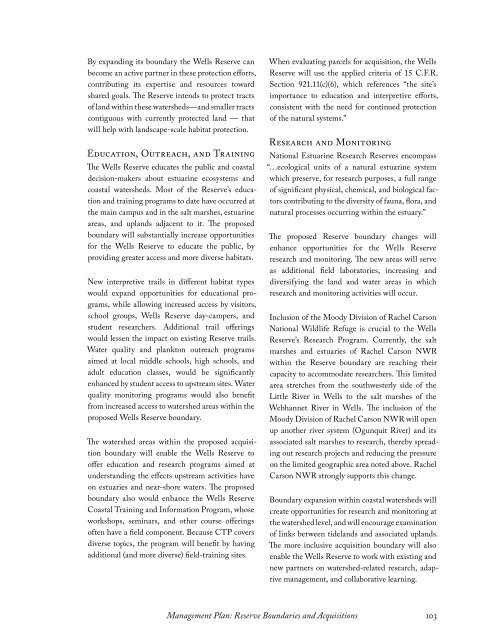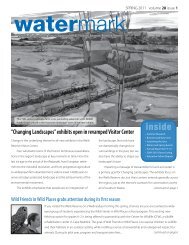Management Plan - National Estuarine Research Reserve System
Management Plan - National Estuarine Research Reserve System
Management Plan - National Estuarine Research Reserve System
You also want an ePaper? Increase the reach of your titles
YUMPU automatically turns print PDFs into web optimized ePapers that Google loves.
By expanding its boundary the Wells <strong>Reserve</strong> canbecome an active partner in these protection efforts,contributing its expertise and resources towardshared goals. The <strong>Reserve</strong> intends to protect tractsof land within these watersheds—and smaller tractscontiguous with currently protected land — thatwill help with landscape-scale habitat protection.Education, Outreach, and TrainingThe Wells <strong>Reserve</strong> educates the public and coastaldecision-makers about estuarine ecosystems andcoastal watersheds. Most of the <strong>Reserve</strong>’s educationand training programs to date have occurred atthe main campus and in the salt marshes, estuarineareas, and uplands adjacent to it. The proposedboundary will substantially increase opportunitiesfor the Wells <strong>Reserve</strong> to educate the public, byproviding greater access and more diverse habitats.New interpretive trails in different habitat typeswould expand opportunities for educational programs,while allowing increased access by visitors,school groups, Wells <strong>Reserve</strong> day-campers, andstudent researchers. Additional trail offeringswould lessen the impact on existing <strong>Reserve</strong> trails.Water quality and plankton outreach programsaimed at local middle schools, high schools, andadult education classes, would be significantlyenhanced by student access to upstream sites. Waterquality monitoring programs would also benefitfrom increased access to watershed areas within theproposed Wells <strong>Reserve</strong> boundary.The watershed areas within the proposed acquisitionboundary will enable the Wells <strong>Reserve</strong> tooffer education and research programs aimed atunderstanding the effects upstream activities haveon estuaries and near-shore waters. The proposedboundary also would enhance the Wells <strong>Reserve</strong>Coastal Training and Information Program, whoseworkshops, seminars, and other course offeringsoften have a field component. Because CTP coversdiverse topics, the program will benefit by havingadditional (and more diverse) field-training sites.When evaluating parcels for acquisition, the Wells<strong>Reserve</strong> will use the applied criteria of 15 C.F.R.Section 921.11(c)(6), which references “the site’simportance to education and interpretive efforts,consistent with the need for continued protectionof the natural systems.”<strong>Research</strong> and Monitoring<strong>National</strong> <strong>Estuarine</strong> <strong>Research</strong> <strong>Reserve</strong>s encompass“…ecological units of a natural estuarine systemwhich preserve, for research purposes, a full rangeof significant physical, chemical, and biological factorscontributing to the diversity of fauna, flora, andnatural processes occurring within the estuary.”The proposed <strong>Reserve</strong> boundary changes willenhance opportunities for the Wells <strong>Reserve</strong>research and monitoring. The new areas will serveas additional field laboratories, increasing anddiversifying the land and water areas in whichresearch and monitoring activities will occur.Inclusion of the Moody Division of Rachel Carson<strong>National</strong> Wildlife Refuge is crucial to the Wells<strong>Reserve</strong>’s <strong>Research</strong> Program. Currently, the saltmarshes and estuaries of Rachel Carson NWRwithin the <strong>Reserve</strong> boundary are reaching theircapacity to accommodate researchers. This limitedarea stretches from the southwesterly side of theLittle River in Wells to the salt marshes of theWebhannet River in Wells. The inclusion of theMoody Division of Rachel Carson NWR will openup another river system (Ogunquit River) and itsassociated salt marshes to research, thereby spreadingout research projects and reducing the pressureon the limited geographic area noted above. RachelCarson NWR strongly supports this change.Boundary expansion within coastal watersheds willcreate opportunities for research and monitoring atthe watershed level, and will encourage examinationof links between tidelands and associated uplands.The more inclusive acquisition boundary will alsoenable the Wells <strong>Reserve</strong> to work with existing andnew partners on watershed-related research, adaptivemanagement, and collaborative learning.<strong>Management</strong> <strong>Plan</strong>: <strong>Reserve</strong> Boundaries and Acquisitions103




